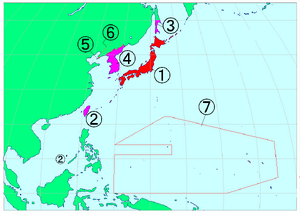| |||||
| Anthem | "Kimigayo (Imperial Reign)" | ||||
| Capital | Tokyo | ||||
| Largest city | Tokyo | ||||
| Other cities | Kobe, Kyoto, Osaka, Nagoya and Yokohama | ||||
| Language | Japanese | ||||
| Religion main |
State Shinto (Official) | ||||
| others | Buddhism, Roman Catholicism and Protestantism | ||||
| Government | Monarchy (Constitutional monarchy since 1890) | ||||
| Emperor: | |||||
| Prime Minister: | |||||
| Area | n/a km² | ||||
| Population | n/a | ||||
| Established | 1868 | ||||
| Currency | yen (¥) | ||||
| Organizations | League of Nations (1920-1934), Greater East Asian Prosperity Alliance (since 1934) | ||||
The Empire of Japan ((Kyūjitai: 大日本帝國; Shinjitai: 大日本帝国; Romaji: Dai Nippon Teikoku; officially Great Japan or Empire of Great Japan; (more widely known as Imperial Japan or the Japanese Empire) was a political entity that existed between the Meiji Restoration in 1868 until its defeat in the Great Pacific War and Revolution in 1946. Succeeded by the Democratic Republic of Japan.
The country's rapid industrialization and militarization under the slogan Fukoku Kyōhei (富国強兵, Enrich the Country, Strengthen the Army), led to its emergence as a world power eventually culminating in the conquest of a large part of the Asia-Pacific region.
The Emperors during this time, which spanned the Meiji, Taishō, and Shōwa eras, are now known in Japan by their posthumous names, which coincide with those era names: Emperor Meiji (Mutsuhito), Emperor Taishō (Yoshihito), and Emperor Shōwa (Hirohito).
Politics[]
The Meiji Constitution of 1881, provided for a form of constitutional monarchy based on the Prussian model, in which the Emperor of Japan was an active ruler and wielded considerable political power, but shared this with an elected Diet. An immediate consequence of the Meiji Constitution was the opening of the first Parliamentary government in Asia.
The Meiji Constitution established clear limits to the power of the executive branch and the absolutism of the Emperor. It also created an independent judiciary. However, it was ambiguous in wording, and in many places self-contradictory. The leaders of the government and the political parties were left with the task of interpretation as to whether the Meiji Constitution could be used to justify authoritarian or liberal-democratic rule. It was the struggle between these tendencies that dominated the government of the Empire of Japan.
Territory of the Empire of Japan[]

Empire of Japan in 1920
(1) The Home Islands (also called Inner Japan or Inner Lands). This are:
- Kuril Islands
- Hokkaidō
- Honshū
- Shikoku
- Kyūshū
- Izu Islands
- Ogasawara Islands
- Ryukyu Islands
It also includes the following annex territories
- (2)
 Taiwan (1895), From China
Taiwan (1895), From China - (5) and (6)
 Kwantung Leased Territory (1905) from Russia. It includes the ports of Lüshunkou (Port Arthur, or Ryojun) and Dalian (Dal'niy, or Dairen)
Kwantung Leased Territory (1905) from Russia. It includes the ports of Lüshunkou (Port Arthur, or Ryojun) and Dalian (Dal'niy, or Dairen) - (3) Karafuto Prefecture (1907), South Sakhalin
- (4)
Chōsen (Korea 1910) Japanese Protectorate 1905-1910, annexed 1910
- (7)
 Nan'yō (南海, South Sea 1919) from German Empire
Nan'yō (南海, South Sea 1919) from German Empire
Economic development[]
The process of modernization was closely monitored and heavily subsidized by the Meiji government, enhancing the power of the great zaibatsu firms such as Mitsui and Mitsubishi. Hand in hand, the zaibatsu and government guided the nation, borrowing technology from the West. Japan gradually took control of much of Asia's market for manufactured goods, beginning with textiles. The economic structure became very mercantilistic, importing raw materials and exporting finished products — a reflection of Japan's relative scarcity of raw materials.
From 1894, Japan built an extensive empire that included Taiwan, Korea, Manchuria, and parts of northern China. The Japanese regarded this sphere of influence as a political and economic necessity, which prevented foreign states from strangling Japan by blocking its access to raw materials and crucial sea-lanes. Japan's large military force was regarded as essential to the empire's defense and prosperity by obtaining natural resources that the Japanese islands lacked.
Military[]
The Military consisted of the Imperial Japanese Army (IJA) and the Imperial Japanese Navy (IJN). The Ministries of War and Navy are in charge of the administration of the IJA and IJN. Although part of the Cabinet, they answerable directly to the Emperor of Japan and not to the Prime Minister of Japan. The minister was an army or navy officer in active duty.
However the real power resides in the Imperial General Headquarters. It was established in 1893 to coordinate efforts between the IJA and IJN. The Imperial General Staff Headquarters was completely independent of the civilian government of the Empire of Japan, including the Cabinet and even the Prime Minister of Japan. ix


